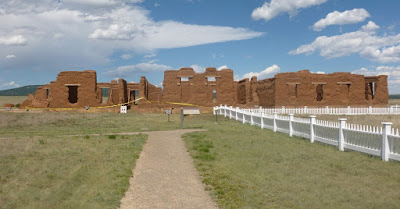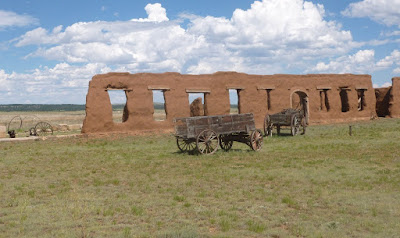After leaving Capulin Volcano, I went back to Raton to find some food and continued southward on I-25 to Fort Union National Monument. On the way, I stopped for gas and watched a fellow customer drive away from the pump with the nozzle still in his vehicle. Fortunately, the hose was detachable from the pump, so there was no permanent damage. I eventually reached Fort Union by way of New Mexico Highway 161.
Fort Union was active from 1851 to 1891, and during its lifetime was located in three places close to each other. It was used to defend against both the Apache and the Confederacy, which included nearby Texas, and was a stop along the Santa Fe Trail. The current ruins, made mostly of red adobe, are from the fort's third incarnation, but nearby earthworks are from its second phase.
After stopping in at the visitor's center, where I was told that there's no fee, I walked over to what was once the fort's hospital. The white picket fence, yellow tape, and "keep off" signs are modern additions.
Fort Union was active from 1851 to 1891, and during its lifetime was located in three places close to each other. It was used to defend against both the Apache and the Confederacy, which included nearby Texas, and was a stop along the Santa Fe Trail. The current ruins, made mostly of red adobe, are from the fort's third incarnation, but nearby earthworks are from its second phase.
After stopping in at the visitor's center, where I was told that there's no fee, I walked over to what was once the fort's hospital. The white picket fence, yellow tape, and "keep off" signs are modern additions.
In this picture, the closer ruin was part of the laundresses' quarters, which were part of the perimeter of a corral. The farther ruin may have been part of company quarters.
This was the military prison.
The ruins in the corner are from a bakery, which is part of the perimeter of another corral. Similarly to the other corral above, the adjacent walls may have been part of another quarters for laundresses. According to a sign, the walkway in the lower left was part of the Santa Fe trail.
This area was part of the mechanic's corral, and now includes these two old wagons.
These were part of the fort's storehouses.
This area, including fireplaces and chimneys, was the officers' quarters.
Near the officers' quarters are a flagpole and a cannon. In the background are the prison, to the left and partially obscured by another structure, and the hospital, to the right.
Here's a closer shot of the cannon. In the background are the hospital, in the center, and the visitor's center, to the right.
Pretty close to the visitor's center, and thus near the conclusion of my walk, are this covered wagon and some tents. According to a sign, the wagon was pulled by mules.
For more on Fort Union, go to Legends Of America and City-Data.










No comments:
Post a Comment